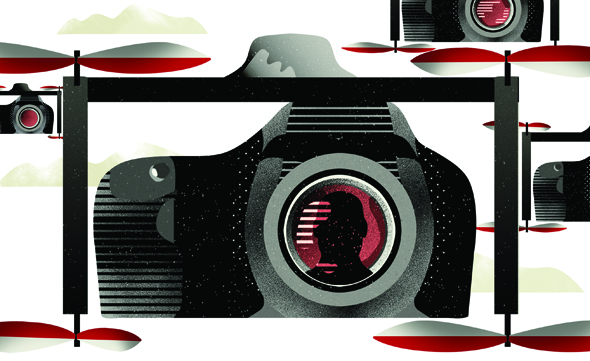
The next great revolution in journalism might just be found at the Amazon store. It is called a drone, and one particular favorite of enthusiasts is the DJI Phantom quadcopter. Battery-operated and GPS-guided, it can cross the horizon at up to 22 miles-per-hour and produce what its manufacturer calls dramatic cinema-quality video.
These are not the drones common in news reports of late. They operate by handheld remote and to my knowledge have never been used to assassinate terrorists in the mountains of Pakistan. But if you’re a journalist, they can do amazing things–like glide through the smoked skies over a raging forest fire to track its forward path, or capture the game-winning touchdown at the local high school football championship. At the moment, the media is banned, in most circumstances, from using drones to cover a news story. Whether that should be the case, and whether these drones have the kinds of journalistic powers that could transform storytelling, are questions that writer Louise Roug explores in her provocative cover piece on the subject.
As with many new technologies that are unchecked and untried, our society can have a reflexive compulsion to reach for a straitjacket before letting them loose. Bind it until we understand it. That’s what we’re doing now with civilian drones. And what’s particularly odd is that the Federal Aviation Administration is, at the moment, the government agency that has turned itself into the arbiter of whether journalists should be allowed to use drones in their reporting. In other words, an agency whose expertise lies in aeronautics and cockpit procedures is now the central player in an issue that ought to be about the First Amendment. Something’s not right.
At quick glance, the FAA’s rules seem wobbly. Unmanned Aerial Systems, as drones are officially called, are banned from the skies when they are being used for commercial purposes, but hobbyists can fly their hearts out if they don’t climb into commercial air space. In other words, a private citizen who takes her Phantom quadcopter to the scene of a train crash would likely be operating within the law. But a journalist who goes to the same crash site while working for his TV station would be doing so illegally. And so by the FAA’s logic, if a drone is up there to make a buck it’s somehow more dangerous to the skies than a drone with no such mission would be. This logic ought to be particularly disturbing to journalists because their use of drones, in many cases, could be argued to be in the public interest. Once this idea settles in, it is not hard to start worrying about the notion of the FAA as arbiter of press freedom.
New technology is never easily reined in–just look at the internet. But it should be an especially considered process when it leads the federal government to restrain journalists trying to do their jobs.
Roug offers a vital introduction to these issues that should be a must-read for anyone dwelling in these pre-drone days of journalism. Change is coming.
In another piece in this issue by assistant editor Alexis Sobel Fitts, CJR looks at traffic-marvel Upworthy, the two-year-old website that has made its mark by giving viral content a good name. Or at least that’s the goal. Upworthy’s founders set out to build success by building audience. Only instead of doing it with, say, Justin Bieber’s lawbreaking escapades, they’re doing it by putting a gloss on weighty, hard-hitting, and usually heartbreaking subjects. For their efforts, they’ve grown at a faster pace than the Huffington Post or BuzzFeed. Fitts looks at why.
Also in this issue, Columbia University journalism professor Howard French breaks new ground in dissecting the saga behind Bloomberg’s foray into investigative journalism, Chinese government corruption, and the backfire that came next. French’s dogged reporting puts it all in a fuller light.
I hope you enjoy the issue.
Elizabeth Spayd is the editor in chief and publisher of CJR.
